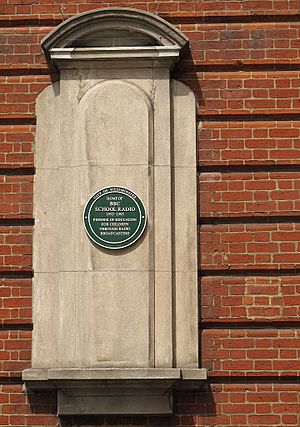BBC School Radio facts for kids
 |
|
|
|
|---|---|
| Broadcast area | United Kingdom |
| Programming | |
| Affiliations | BBC Radio 4, BBC Learning |
| Ownership | |
| Owner | BBC |
| Technical information | |
| Repeater(s) | BBC |
| Links | |
| Webcast | Podcasts |
| Website | BBC School Radio |
BBC School Radio is a part of the BBC that creates audio learning materials. These resources are designed to help primary schools in the United Kingdom with their lessons.
The History of School Radio
BBC School Radio has a long and interesting past. It started almost 100 years ago!
Early Days of Broadcasting
The very first broadcast for schools happened on April 4, 1924. It was organized by the British Broadcasting Company. A composer named Sir Walford Davies gave a music lesson. This broadcast went out from London's second-ever radio station, called 2LO.
In 1928, the Central Council for School Broadcasting (CCSB) was created. This group helped decide what programmes schools needed. Teachers gave their ideas to make sure the broadcasts were useful.
From 1929 to 1957, a woman named Mary Somerville was in charge. By the 1930s, secondary schools also started listening. They even added lessons for learning foreign languages.
School Radio During Wartime
During the Second World War, school radio became very important. All the different regional programmes were combined into one service. There was even a short news broadcast. It helped explain the confusing war situation to children. By 1942, half of all British schools were tuning in.
After the War
After the war, in 1947, the School Broadcasting Council for the United Kingdom was set up. It included schools in Scotland and Wales. By 1953, over 25,000 British schools were using school radio. Different times were set aside for primary and secondary schools.
The years from the 1960s to the 1980s were a "golden age" for school radio. By the early 1970s, about 90% of schools were using the service. The BBC made around 80 different series each year. This meant about 16 hours of programmes every week.
How Programmes Were Broadcast
Originally, school programmes were on the BBC Home Service. This changed to BBC Radio 4 in 1967. Later, in 1990, they moved to BBC Radio 5 and BBC Radio 3. Radio 5 was on a lower quality signal, so programmes were repeated on Radio 3 overnight. This allowed schools to record them with better sound.
In 1994, Radio 5 closed down. The school programmes then moved to BBC Radio 3 during the day. From 1996, all programmes were broadcast overnight on Radio 3. This allowed schools to record them easily. Finally, they moved to the digital version of BBC Radio 4. Over-the-air broadcasts stopped completely on June 28, 2018.
The Move to Online Learning
Since 2003, all school radio programmes have been available online. The invention of podcasting made it even easier. Now, teachers and students can listen to programmes whenever they want.
Other Educational Broadcasts
TV broadcasting for schools started on May 13, 1957. The BBC began its own schools television service a few months later. These TV programmes were shown on BBC1 and later moved to BBC2.
Celebrating Anniversaries
On April 4, 1984, a special programme celebrated sixty years of BBC Schools Radio. It was called Faith, Hope and Clarity. Later that year, a three-day festival was held in Birmingham. Famous people like Duncan Goodhew and Sue Lawley hosted it.
Where Programmes Were Made
In 1939, the School Broadcasting Department moved to Bristol. Later, in 2011, School Radio moved to the new BBC Bridge House in MediaCityUK. This is also home to other BBC learning services like BBC Bitesize and BBC Teach. A small team in Scotland makes programmes just for Scottish schools.
Famous Presenters
Many presenters have worked on BBC School Radio. Some of them include:
- Sophie Aldred
- Sandra Kerr
- Simon Mayor
- Rhoda Power
- Andy Day
- Cat Sandion
- Gemma Hunt
- Ben Faulks
- Steven Kynman
What You Can Learn
Today, BBC School Radio is an online-only service. New content is uploaded throughout the year. This means you don't have to follow a strict broadcast schedule.
Subjects Covered
The content is divided into twelve main subjects:
- Collective Worship
- Curriculum for Excellence (for Scottish schools)
- Drama
- Dance
- Early Learning
- English
- Geography
- History
- Mathematics
- Modern Foreign Languages
- Music
- PSHE - Citizenship
The English section has many classic stories. Famous voices read these stories. For example, The Wind in the Willows is read by Bernard Cribbins. The Tales of Hans Christian Andersen are read by Anne-Marie Duff, Sir Derek Jacobi, David Tennant, and Penelope Wilton.
In the past, you could buy programmes on CD or DVD. Now, all programmes are available as podcasts online.
Past Programmes You Might Like
BBC School Radio has created many interesting programmes over the years. Some older ones include:
- In the News - This programme helped explain current events to children aged 9 to 12.
- Wavelength - This show covered youth culture.
- Talks to Sixth Forms - This series featured famous speakers like G. K. Chesterton and E. M. Forster.
- How Things Began - A natural history programme from 1943.
- Make Up Your Mind - A discussion programme for older students.
See Also
- BBC Schools – a similar television service that started in 1957
- BBC Learning

